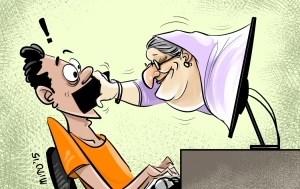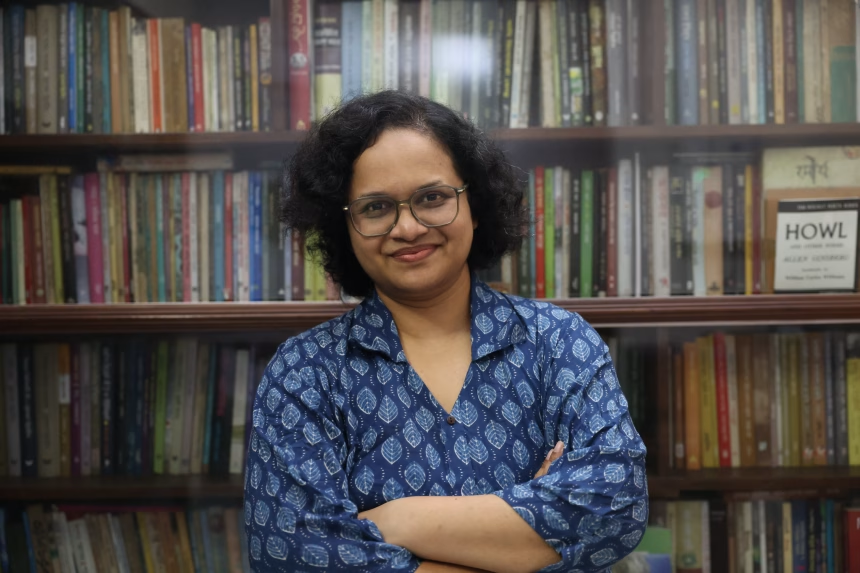In Bangladeshi cartooning, Nasreen Sultana Mitu is a name that commands admiration. From her haunting Rana Plaza cartoon that touched millions to the vibrant worlds of Dhaka Comics, her art has become both a mirror and a megaphone. The Associate Editor of Unmad, Mitu blends creativity with purpose, from guiding young artists to developing science-learning tools through Project Tiktaalik.
Fresh from sharing her expertise at Harvard’s ComSciCon workshop, she sat down with Times of Bangladesh to talk about her journey and the joy of using art to spark change. The interview was conducted by Shamim Shopno.
The full interview follows…
TIMES: What inspired you to step into the world of cartooning back in 2006 and how did your journey begin?
Mitu: I’ve been drawing since childhood, copying pictures from storybooks or other drawings, like every other child does. I first went to Unmad as a fan, just to say I wanted to draw. My work was terrible then, and I truly believed I wasn’t good enough. The editor, Ahsan Habib, is really the reason I became a cartoonist. If it weren’t for him, I don’t think I would have pursued this path.
Back then, there were very few women in cartooning. Just six months before I joined, Shikha Apu (Shahanara Nargis Shikha) had become the first female cartoonist at Unmad. I still remember there was an editorial celebrating her joining. That motivated me.
TIMES: As the most prominent female cartoonist in Bangladesh, what kind of difficulties have you faced and how have gender dynamics shaped your works?
Mitu: The challenges for women have changed. These days, while political cartooning has shrunk, the illustration field has grown. Now there are more agencies needing visuals and more opportunities for earning. Earlier, cartooning offered very few jobs outside newspapers.
Still, being a woman brings something valuable: the chance to offer a female perspective. No matter how empathetic a male cartoonist is, he can’t fully capture the everyday struggles women face. The more diverse our voices become, the richer and more authentic our storytelling will be.

TIMES: Your 2013 Rana Plaza cartoon struck a powerful chord. How do you conceptualise such socially impactful pieces?
Mitu: That was a very emotional time for me. Timing played a big role in how that cartoon connected with people. Back then, social media wasn’t as widespread, but the cartoon went everywhere. It became overwhelmingly viral. Honestly, it was such a tragic event that I never wanted to ‘go viral’ in that way.
Everyone was devastated over Rana Plaza, and I think that collective grief is why so many connected with it. It also became a learning experience, seeing how people from different sectors interpret such work.
TIMES: Could you share how Project Tiktaalik came about and how cartoons can transform children’s engagement with science?
Mitu: Project Tiktaalik started in 2016 and is still running, though between 2020 and 2024 it slowed down a bit. Now we’re back with a proper budget.
The response from children has been amazing, but our biggest challenge is distribution. Book distribution in Bangladesh is very poor, which limits our reach. I’m not very comfortable working with sponsors, so I try to fund things myself. Without project funding, doing outreach outside Dhaka becomes difficult. Still, connecting with so many children in the early stages keeps us motivated.

TIMES: Having taught at the University of Rajshahi, what unique perspectives did you gain from fusing cartoons with education?
Mitu: That’s why I started Project Tiktaalik. After my master’s, I had to decide whether to fully pursue academia or stick to cartooning. My subject is education, specifically science education. One day, I realised, why not do both?
Those six years of teaching were truly rewarding. Then, in 2015, I attended AAAS conference, the largest science conference in the US. And there was one session by Larry Gonick which inspired me. It was eye-opening to see how effectively comics were used to communicate science. After coming back, I started experimenting, and in 2016, Project Tiktaalik was born.
TIMES: What was your experience presenting at Harvard’s ComSciCon workshop like?
Mitu: ComSciCon is such a unique platform. It started 13 years ago at Harvard and MIT, led by PhD students. Now, every year, they select only about 40 participants from across North America, so being among them was special.
In Bangladesh, science communication isn’t a recognised discipline yet. Being in a space where everyone spoke that language was empowering. Another highlight was the ‘Create-A-thon,’ where participants pitched projects to us. It reinforced how crucial it is for scientists to bridge the gap and take research beyond academic papers.
TIMES: In your ‘Meet the Faces’ exhibition, how did you adapt traits of your subjects to balance humour?
Mitu: Caricature is a completely different field. Most people know it from political cartoons, often satirical takes on public figures. But caricature isn’t only about satire; it’s about observing someone, their character, their quirks, their story and portraying them from a unique perspective.
Outside of science comics, caricature is my true love. That’s why the ‘Meet the Faces’ exhibition was so special. It was, I believe, the first caricature exhibition in Bangladesh. I’ve been meaning to do another one ever since, maybe next year.
TIMES: As a woman, what challenges and opportunities have you encountered at Unmad and Dhaka Comics?
Mitu: It never really felt challenging. Unmad is one of Bangladesh’s most stable and iconic magazines; for my generation, working there was a dream. I often say the biggest influence in my career is Ahsan Habib, perhaps even more than my parents.
With Dhaka Comics, I was there from the beginning with Mehedi Haque. Since I wasn’t handling the business side, I didn’t face the major challenges; I focused on my creative work.
TIMES: Looking ahead, what are your aspirations for your art and the broader cartoon landscape?
Mitu: My dream is to see science communication recognised as a serious field in Bangladesh and to contribute to building that space. Since my expertise lies in cartoons and comics, I want to keep using this medium to reach more children and communities.
I also want to create opportunities for young people, those in STEM who are unsure how to connect their work to the public. Visual storytelling is such a powerful tool to spark curiosity. Ultimately, my goal is to help the younger generation develop a scientific mindset in their everyday lives.


